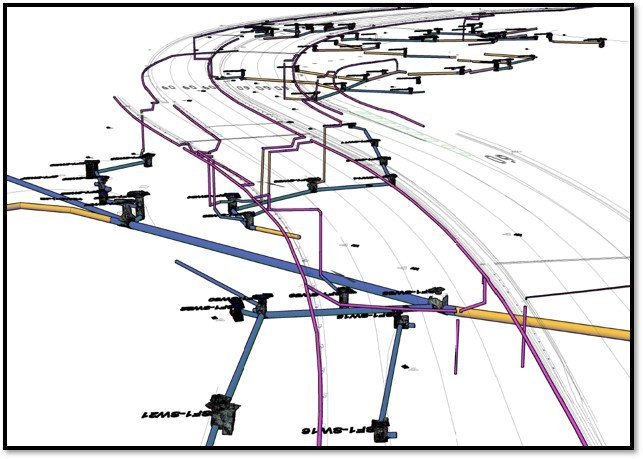Rapid response to major disruption
In February 2017, Sydney experienced a major storm incident, which saw a month’s worth of rain (nearly 50mm) fall in just one hour. This resulted in flash flooding and extensive damage across the city.
The Anzac Bridge was severely impacted, with four of the five lanes on the Western Distributor, approaching Victoria Road and City West Link, closed. Approach ramps were also jammed, causing major delays. While Eastbound lanes remained open, traffic in that direction was still badly affected.
The water level on the bridge was up to 300mm and the bridge had to be closed for several hours, in order to drain. Once reopened, traffic still moved extremely slowly, causing major delays.
The maintenance contract for the Anzac Bridge was with a joint venture (JV) comprising Ventia/Boral/Amey. Following this event, Durkin was engaged by the JV to conduct urgent utility and drainage investigations and detail surveys on the Eastern and Western approaches to the bridge, the drainage assets on the underside of the bridge and the underground assets.
Durkin Construction Senior Project Manager, Mehdi Heydari, said they received an urgent call to commence the works and had to cease all other projects and respond immediately.
“The flooding brought to light a raft of issues,” said Mehdi.
“It was imperative they be thoroughly investigated and rectified before the next major rainfall.”
Comprehensive investigations
The scope of works to complete the investigations included:
Comprehensive 3D Utility Surveys
Quality Level A (QL-A) and Quality Level B (QL-B) Utility Surveys
Comprehensive 3D Drainage Survey, including 3D scanning of the pits and CCTV Surveys
Detail Survey
“The bridge and its associated infrastructure incorporate a highly detailed drainage network,” explained Mehdi.
“From the surface, you can see into the pits but it’s not possible to tell how they are connected, how the stormwater is disposed of or why it was slowing.
“There were obviously defects and they were impacting all of the network. To identify and rectify the defects, we had to investigate the entire drainage network and associated underground facilities.
“We had to not only consider the drainage network on the bridge but also under the bridge and under the ground below the bridge.
“To develop an accurate picture of the overarching conditions, we created a highly accurate 3D model of the entire drainage network.
“To achieve this, we employed a variety of techniques, including using a CCTV with robotic tractors inside the pits. We ran them through all of the pipes, to assess various angles and defects. We also produced 3D scans of more than 400 drainage pits and inlets and a complete topographical survey of the bridge and its approaches. QL-A and QL-B Utility Surveys were undertaken for underground services and some of which were embedded in the bridge (and under the surface of the bridge deck), including lighting, etc. We also used concrete scanning to find rebars in the concrete slabs.
“Pavement investigations were undertaken to determine the levels and grades of pavements, and the core thickness of the asphalt and concrete. Soil conditions and levels on approaches were also assessed.
“It was important for us to know the exact details of the pavement structure and the approaches, so they could be reinstated to those specs following our investigations.”
Major Logistics
Because the Anzac Bridge is a major transport link into the Sydney CBD, it is a high-volume road which experiences very high traffic numbers during peak hours and consistently high volume at other times of the day. As such, due to the potentially disruptive nature of the investigations, Durkin had highly limited windows of opportunity to undertake the work, with the majority completed at night.
Mehdi said managing the range of resources required and the need to have a number of crews working consecutively during the available windows, presented significant logistical challenges.
“This was a high profile, fast-tracked, multidisciplinary project,” said Mehdi.
“As well as the physical time constraints, the need to utilise different skills, undertake a wide variety of activities and encompass all of the differing areas of investigation, added to the complexity of the project.
“Total site attendance was 63 night and day shifts and, at some stages, we had up to nine separate crews allocated per shift.
“Adding to the complexity, as we were undertaking the investigations, the designers were engaged to enable the upgrades to be constructed in real time.
“To deliver the high-quality outputs required within such a tight timeframe, post-processing of the investigative data was carried out as the site works were progressing. Such was the urgency of the project, we were processing the data and delivering updates to the designers daily.
“This highly collaborative process ensured a smooth transition to the design and construction phase and the tight timeframes for all of the deliverables were met,” concluded Mehdi.




